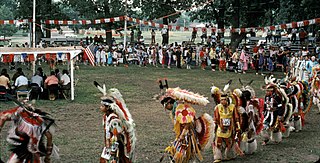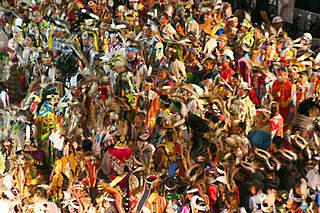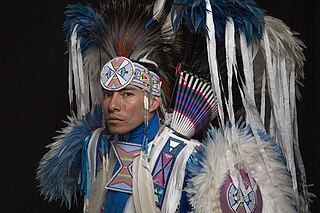Related Research Articles

The Crow, whose autonym is Apsáalooke, also spelled Absaroka, are Native Americans living primarily in southern Montana. Today, the Crow people have a federally recognized tribe, the Crow Tribe of Montana, with an Indian reservation, the Crow Indian Reservation, located in the south-central part of the state.

A powwow is a gathering with dances held by many Native American and First Nations communities. Inaugurated in 1923. Powwows today are an opportunity for Indigenous people to socialize, dance, sing, and honor their cultures. Powwows may be private or public, indoors or outdoors. Dancing events can be competitive with monetary prizes. Powwows vary in length from single-day to weeklong events.

Floyd Westerman was a Sisseton Dakota musician, political activist, and actor. After establishing a career as a country music singer, later in his life he became an actor, usually depicting Native American elders in American films and television. He is also credited as Floyd Red Crow Westerman. As a political activist, he spoke and marched for Native American causes.

Plenty Coups was the principal chief of the Crow Tribe and a visionary leader.

Fancy dance, Pan-Indian dancing, Fancy Feather or Fancy War Dance is a style of dance some believe was originally created by members of the Ponca tribe in the 1920s and 1930s, in an attempt to preserve their culture and religion. It is loosely based on the war dance. Fancy dance was considered appropriate to be performed for visitors to reservations and at "Wild West" shows. But today, fancy dancers can be seen at many powwows across the nation and even the world.

The Omaha Tribe of Nebraska are a federally recognized Midwestern Native American tribe who reside on the Omaha Reservation in northeastern Nebraska and western Iowa, United States. There were 5,427 enrolled members as of 2012. The Omaha Reservation lies primarily in the southern part of Thurston County and northeastern Cuming County, Nebraska, but small parts extend into the northeast corner of Burt County and across the Missouri River into Monona County, Iowa. Its total land area is 307.03 sq mi (795.2 km2) and the reservation population, including non-Native residents, was 4,526 in the 2020 census. Its largest community is Pender.

The Crow Fair was created in 1904 by Crow leaders and an Indian government agent to present the Crow Tribe of Montana as culturally distinct and modern peoples, in an entrepreneurial venue. It welcomes all Native American tribes of the Great Plains to its festivities, functioning as a "giant family reunion under the Big Sky." Indeed, it is currently the largest Northern Native American gathering, attracting nearly 45,000 spectators and participants. Crow Fair is "the teepee capital of the world, over 1,500 teepees in a giant campground," according to 2011 Crow Fair General Manager Austin Little Light.

A parfleche is a Native American rawhide container that is embellished by painting, incising, or both.

The Gourd Dance is a Kiowa dance and song tradition that has become popular at modern powwows in southwestern Oklahoma.

Over the past 42 years, the Gathering of Nations has grown from a simple dream into one of North America's most celebrated annual festivals, known for its fair competitions, cultural significance, and impactful community outreach.

Wild West shows were traveling vaudeville performances in the United States and Europe that existed around 1870–1920. The shows began as theatrical stage productions and evolved into open-air shows that depicted romanticized stereotypes of cowboys, Plains Indians, army scouts, outlaws, and wild animals that existed in the American West. While some of the storylines and characters were based on historical events, others were fictional or sensationalized.

Christian Parrish Takes the Gun, known professionally as Supaman, is an Apsáalooke rapper and fancy war dancer who grew up in Crow Agency, Montana.

The Halluci Nation, formerly known as A Tribe Called Red, is a Canadian electronic music group who blend instrumental hip hop, reggae, moombahton and dubstep-influenced dance music with elements of First Nations music, particularly vocal chanting and drumming. Based in Ottawa, Ontario, the group consists of Tim "2oolman" Hill, and Ehren "Bear Witness" Thomas. Former members include co-founder DJ Jon Deck and Dan "DJ Shub" General, who left the band for personal reasons in spring 2014, and was replaced by Hill. Co-founder Ian "DJ NDN" Campeau left the band for health reasons in October 2017, with the band opting to remain a duo for the time being.

The grass dance or Omaha dance is a style of modern Native American men's pow wow dancing originating in the warrior societies on the Northern Great Plains. Unlike most forms of pow wow dancing, the grass dance regalia generally has no feathers besides the occasional roach feather. The regalia consists of brightly colored fringe made of either yarn, broadcloth, or ribbon.
Bently Spang is a multidisciplinary artist, educator, writer, curator and an enrolled member of the Tsitsistas/Suhtai Nation in Montana. His work has been exhibited widely in North America, South America, and Europe.

Wild Westing was the term used by Native Americans for their performing with Buffalo Bill's Wild West and similar shows. Between 1887 and World War I, over 1,000 Native Americans went "Wild Westing." Most were Oglala Lakota from their reservation in Pine Ridge, South Dakota, the first Lakota people to perform in these shows. During a time when the Bureau of Indian Affairs was intent on promoting Native assimilation, William Frederick Cody used his influence with U.S. government officials to secure Native American performers for his Wild West. Cody treated Native American employees as equals with white cowboys.

Wendy Red Star is an Apsáalooke contemporary multimedia artist born in Billings, Montana, in the United States. Her humorous approach and use of Native American images from traditional media draw the viewer into her work, while also confronting romanticized representations. She juxtaposes popular depictions of Native Americans with authentic cultural and gender identities. Her work has been described as "funny, brash, and surreal". Red Star was awarded a MacArthur Fellowship in 2024.

The REDress Project by Jaime Black is a public art installation that was created in response to the missing and murdered Indigenous women (MMIW) epidemic in Canada and the United States. The on-going project began in 2010 and commemorates missing and murdered indigenous women from the First Nations, Inuit, Métis (FNIM), and Native American communities by hanging empty red dresses in a range of environments. The project has also inspired other artists to use red to draw attention to the issue of MMIW, and prompted the creation of Red Dress Day.

Mitchelene BigMan is an Apsáalooke (Crow/Absaroke) / Minitari (Hidatsa) U.S. Army veteran and advocate, best known for establishing the Native American Women Warriors (NAWW), the first all-female native Color Guard.
Elias Jade Not Afraid is an Apsáalooke (Crow/Absaroke) artist known for his traditional and non-traditional beadwork.
References
- ↑ Her Many Horses, Emil, ed. (2007). Identity by design : tradition, change, and celebration in native women's dresses (1st ed.). Washington (D.C.): National Museum of the American Indian. ISBN 978-0061153693.
- ↑ "Woman's dress". National Museum of the American Indian . Smithsonian Institution. Archived from the original on 7 December 2023. Retrieved 7 December 2023.
- 1 2 "Native Profile – Dora C. Birdshead". PowWows.com. 8 August 2011. Archived from the original on 25 June 2022. Retrieved 7 December 2023.
- ↑ Daffron, Brian (8 August 2007). "Old Elk represents 'Crow style' throughout circuit". Indian Country Today . Archived from the original on 9 November 2016. Retrieved 7 December 2023.
- ↑ "Apsaalooke Double Beat (Sung For Head Lady Dancer Dora Old Elk)". Myspace.